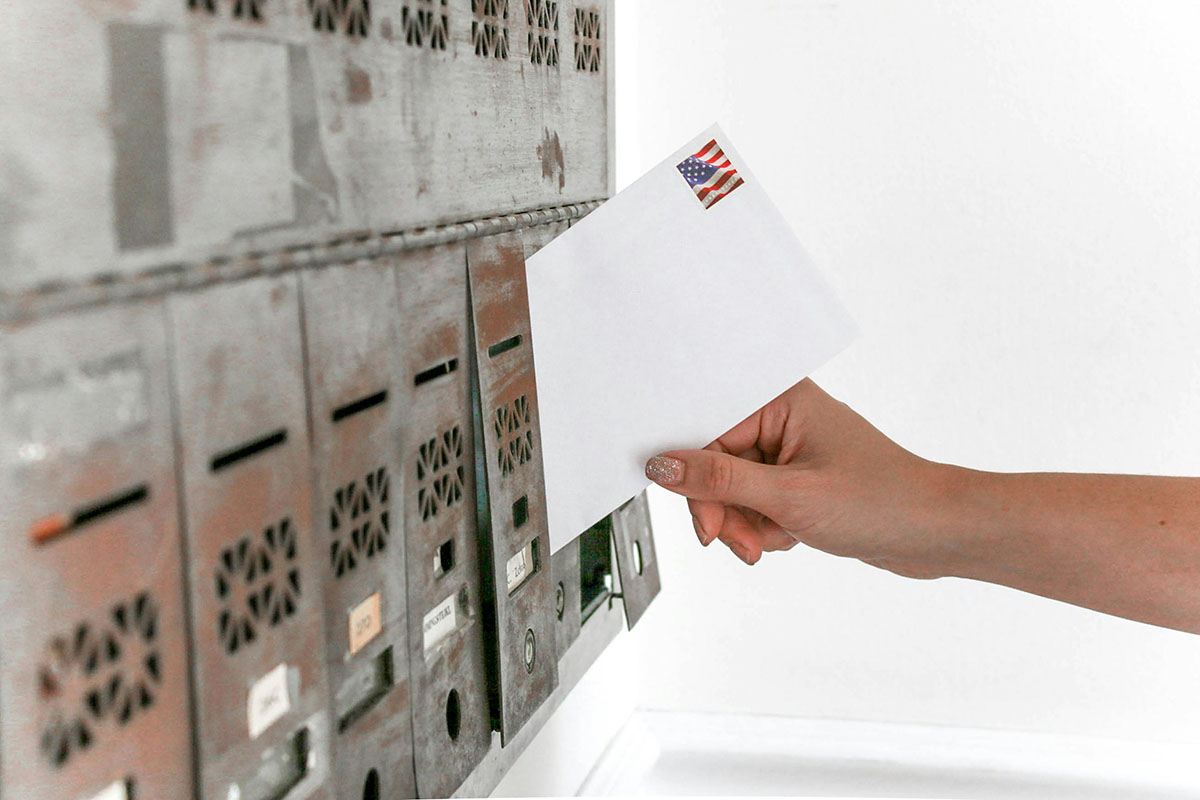Introduction to EDDM
EDDM, which stands for Every Door Direct Mail, is a service offered by the United States Postal Service that allows businesses and organizations to send direct mailings to every home and residency within a carrier route for a set price, without needing to know the individual mailing addresses.
To use EDDM, you create your mailing pieces according to USPS specifications, bring the printed mail pieces to your local post office, and pay a fee based on how many pieces you are sending and to which carrier routes. The post office then delivers the mail pieces to every address on those routes, allowing you to easily saturate a geographic area with your message.
Some key benefits of using EDDM include:
- No mailing lists or address knowledge needed – you can target by carrier route rather than individual names and addresses
- Fixed pricing – the price is determined only by how many pieces you are sending and to which routes, regardless of number of residences
- Savings over first class mail – EDDM can be significantly cheaper for saturation mailings
- Fast turnaround – mail pieces typically delivered within 6-10 days of dropoff
- Geographic targeting – allows you to target specific neighborhoods or regions
- Measurable results – easy to see response rates by carrier routes targeted
EDDM provides an affordable, efficient way to get your message directly into the hands of local residents and businesses for political campaigns, small businesses, nonprofits, and a wide range of organizations.
History and Growth of EDDM
Every Door Direct Mail (EDDM) started as a service offered by the United States Postal Service (USPS) in 2011. It provides businesses and organizations a more affordable way to send promotional mailings to potential customers in specific neighborhoods or zip codes without needing mailing lists or addresses.
Prior to EDDM, sending a mailing typically required purchased mailing lists, addresses, and working with a full-service mail house for targeted saturation mailings. EDDM simplified the process by allowing mailers to send to all addresses within a carrier route based on zip code. This opened up direct mail marketing to smaller businesses that previously could not afford the high costs.
Since its introduction, EDDM has grown in popularity among a wide range of businesses due to its simplicity and cost-effectiveness. Market research shows that EDDM spending has increased substantially year-over-year. The number of EDDM mailings sent through the USPS has grown from 1.1 billion pieces in 2011 to over 6 billion pieces in 2018, representing 500% growth in 7 years.
EDDM has become an essential marketing channel for local businesses and organizations. Its targeted delivery and inexpensive postage rates make it one of the most affordable ways to reach local customers and households. The continued growth and adoption of EDDM demonstrates its value for promotional and campaign mailings.
Using EDDM for Political Campaigns
EDDM can be an effective part of a political campaign’s direct mail strategy for several reasons:
- It allows campaigns to target specific neighborhoods and demographics. By selecting particular carrier routes, campaigns can focus their mailings on likely voters in key precincts. This level of targeting is not possible with regular bulk mail.
- It is more affordable than sending individual first-class mail. While not as cheap as bulk mail, EDDM provides finer targeting at a reasonable cost. This allows campaigns to do more mailings within their budget.
- It gets a better response rate than bulk mail. EDDM mailings stand out more than bulk mail and are more likely to be opened and read by recipients. This increases the chance of persuading voters.
- It is easy to coordinate with canvassing. Campaigns can send EDDM to neighborhoods shortly before canvassing them to improve name recognition.
- It allows flexible and timely messaging. EDDM can highlight new issues or events relevant to the campaign as they happen close to election day.
Successful political campaigns have used EDDM as part of their voter contact strategy, including Barack Obama’s 2008 presidential run and Bernie Sanders’ 2016 primary campaign. Both did targeted EDDM mailings to likely voters ahead of rallies or campaign stops in key areas. When combined with door-to-door canvassing, phone banking, and other outreach, EDDM can be a cost-efficient way to persuade and turn out voters.

Targeting Voters with EDDM
Political campaigns use Every Door Direct Mail (EDDM) as a tactical targeting tool to reach specific groups of voters. With EDDM, campaigns can target mailing routes that match desirable demographics and neighborhoods likely to be supportive.
For example, a Democratic campaign may want to target young voters and minorities who tend to skew Democrat. They can use census data to identify ZIP codes and carrier routes with higher percentages of these voters. The campaign then selects these areas for EDDM mailings.
Similarly, a Republican campaign may look for neighborhoods with higher home ownership rates and incomes over $100k, indicators of likely Republican voters. By targeting only these carrier routes, they avoid wasting resources mailing to less receptive audiences.
Campaigns often overlay consumer data like magazine subscriptions and purchasing habits to further refine targets. A route with both high minority populations and subscribers to liberal magazines would be a prime EDDM target.
Because EDDM mailings can be targeted down to the postal carrier route level, campaigns can micro-target very specific voter segments. This enables efficient use of campaign resources to focus on reaching the most likely supporters.
With a data-driven approach, EDDM mailings allow campaigns to penetrate their best areas while avoiding postal routes unlikely to produce results. Savvy use of demographic and consumer data makes EDDM an effective voter targeting tool.
Creating Effective Political Mailers
When creating a political mailer using EDDM, the design and messaging are crucial for connecting with voters. Here are some tips for making effective political mailers:
- Use clear, bold designs: Simple, high-contrast graphics tend to work best. Avoid cluttered designs that are difficult to read. Use the candidate’s logo and colors consistently.
- Highlight the candidate’s name and photo prominently: Research shows that visual recognition of a candidate’s face and name makes a difference. Make sure they stand out.
- Personalize the mailer: Use “Dear Neighbor” and the recipient’s name whenever possible. This makes people more likely to open and read the mailer.
- Focus on 2-3 key messages or calls to action: Don’t overwhelm the reader. Emphasize the most important reasons to vote for the candidate.
- Use action words like “Vote” and “Elect”: Make the desired action clear and urgent. Images of ballots can also be effective.
- Include important dates and deadlines: Note the election date and voter registration deadlines. Make it easy for people to take action.
- Use readable fonts and text sizes: Avoid fancy script and small text, especially for critical info like dates. Use sufficient white space.
- Highlight local/community interests: Relate the candidate’s positions to local concerns. Neighborhood schools, jobs, taxes, etc.
- Use photos that resonate: Family images and local scenes tend to work better than generic patriotic symbols. Test different options.
- Build in tracking codes: Use unique phone numbers or codes to measure response rates and optimize future mailings.
The overall goal is to motivate immediate action in a personalized way. Strong design, clear messaging, effective photos, and local relevance are key to making political mailers via EDDM successful.
Integrating EDDM with Other Campaign Efforts
Political campaigns today use a variety of tactics and channels to reach voters, from TV and online ads to door knocking and phone banking. EDDM can be a powerful addition to these efforts when integrated strategically.
- Coordinate EDDM with TV ads. Send a mailer to arrive just before a new TV ad starts running. Include a call-to-action related to the ad’s key message.
- Reinforce online ads through mail. If running display, video or social ads, send an EDDM piece with similar messaging and visuals. Remind people to visit your site or social pages.
- Provide information to door knockers. Equip your door-to-door canvassers with mailers to leave behind for those not home. This ensures they still get your messaging.
- Follow-up and provide info from phone banking. Mailers can follow-up and provide more details after a phone call. Include key points made and information requested during calls.
- Drive people to events. Promote upcoming local events like rallies, town halls and meet-the-candidate nights via mail. Include logistical details and compelling reasons to attend.
- Thank supporters after donations. Send EDDM thank you notes and campaign updates to those who have donated. Keep them engaged.
The key is coordinating EDDM with other outreach for maximum impact. Timing mailings to reinforce your messaging across channels can go a long way in reaching and persuading voters.
Measuring the Impact of EDDM Mailings
Political campaigns using EDDM mailings have several options for measuring the effectiveness of their efforts. Careful testing, tracking response rates, and analyzing conversion data can provide valuable insights.
Campaigns should consider A/B testing different EDDM designs, offers, and messaging. By sending one version to some neighborhoods and a different version to comparable neighborhoods, campaigns can directly compare results. Evaluating return rates for business reply cards and tracking website traffic driven by EDDM can also demonstrate response.
Analyzing conversion rates is crucial. If an EDDM mailer aims to drive registrations, donations, or event attendance, campaigns should measure those outcomes. Codes on business reply cards and unique website landing pages for each mailer enable clear tracking. Comparing conversion rates by neighborhood can show which areas responded best.
Ultimately, EDDM impact depends on driving the desired action. Well-designed tests, thorough response rate data, and conversion rate analysis provide the insights campaigns need to refine their EDDM strategy and increase effectiveness. Thoughtful measurement brings accountability and demonstrates the value of EDDM mailings in achieving campaign goals.
Case Studies of Successful EDDM Campaigns
Everyday Mail through the Every Door Direct Mail (EDDM) program has proven to be an effective tactic for political campaigns to reach voters. Here are some real world examples and results of campaigns successfully using EDDM:
- During the 2012 presidential election, Barack Obama’s campaign used EDDM to send mailers to targeted groups of voters in swing states. These mailers discussed Obama’s positions and accomplishments on specific issues those voters cared about. The campaign was able to track responses and attribute increased voter turnout to the EDDM mailers.
- In the 2016 Maryland Senate race, candidate Chris Van Hollen used saturation EDDM mailings to likely Democratic voters. By blanketing certain neighborhoods his campaign was able to reinforce his messaging and increase his name recognition. Post-election surveys found the EDDM strategy increased favorability and contributed to his victory.
- A city council candidate in Austin, Texas targeted EDDM to registered voters in specific zoning areas she knew would be impacted by a development project she opposed. The geographically targeted mailers provided details on her opposition and contrasted her stance with her opponent. She credited the mailers for raising awareness and believes they led directly to increased voter support.
- During a special election for Florida’s 13th congressional district in 2018, the leading candidate boosted his turnout by sending EDDM about the election date to 100,000 households of registered Democrats that had a history of infrequent voting in special elections. Analysts believe this tactic expanded his base and was a difference maker in the tight race.
These examples demonstrate that with careful targeting and messaging, EDDM can be pivotal in political campaigns at all levels to reach, inform, persuade and mobilize voters.
Rules and Regulations for Political EDDM
When using EDDM for political campaign mailings, there are important rules and regulations to follow to ensure compliance with postal regulations and election laws.
- The USPS has specific regulations for EDDM mailings that apply to all mailers using the service. This includes format and size requirements, addressing standards, and preparation and postage rules. Political mailers must follow the same EDDM regulations as commercial mailers.
- Political committees and candidates must clearly indicate who has paid for the mailing by including a “paid for by” disclaimer on the mailer. This is required by federal election law and ensures transparency on the source of campaign communications.
- There are state-by-state regulations on the dates when political mail can be sent out before an election. Many states prohibit unsolicited political mailings in the final days leading up to an election to allow voters time to receive and review the information.
- While discounted EDDM prices apply for qualifying political mailers, committees and candidates cannot coordinate or collaborate with the USPS on the mailings in any way. There must be an arm’s length distance with no appearance of USPS endorsement or support.
- Foreign nationals are prohibited under federal law from contributing to U.S. political campaigns. This includes foreign companies and individuals paying for campaign mailings. All EDDM mailings must be paid for by permitted U.S. sources.
- Content standards apply to political mailers just as they do for all mailings. Political committees should ensure mailings do not contain false claims, profanity, or threats that could violate postal regulations.
Following these rules allows political campaigns to fully leverage EDDM while staying within the guidelines for fair elections and postal standards. Consultation with election attorneys and mail professionals is key for political EDDM compliance.
The Future of EDDM in Political Campaigns
EDDM is likely to continue evolving as a tool for political campaigns due to a number of trends and innovations.
Campaigns will be able to leverage improved targeting and personalization capabilities. As campaigns build more detailed voter profiles, they can use EDDM to deliver hyper-targeted mailers tailored to the specific interests and demographics of households. New printing technologies like digital inkjet also enable customization at an individual level.
Integrating EDDM with digital efforts will become more sophisticated. Campaigns can use data gathered from online interactions to refine direct mail outreach. Response rates and impact can also be measured by tracking digital actions driven by EDDM pieces.
The role of EDDM to motivate voter turnout will grow. Well-timed EDDM mailers have proven effective at spurring supporters to go vote on election day. With continued analysis of response rates, campaigns can optimize their EDDM schedule for maximum impact.
Creative and format innovations will enhance effectiveness. Experiments with formats like oversized mailers, sticker campaigns, and multi-touch mail sequences can make EDDM stand out. The design and message testing process will also become more data-driven over time.
While advances in digital channels may affect some types of direct mail, the unique benefits of physical mailers will continue to make EDDM an indispensable part of political campaigns’ outreach strategies. With smart integration of data and technology, EDDM’s place in the campaign playbook seems assured. For more information visit Anchor Software and talk to us about how you can employ EDDM and other Direct Mail technologies into your campaign.






